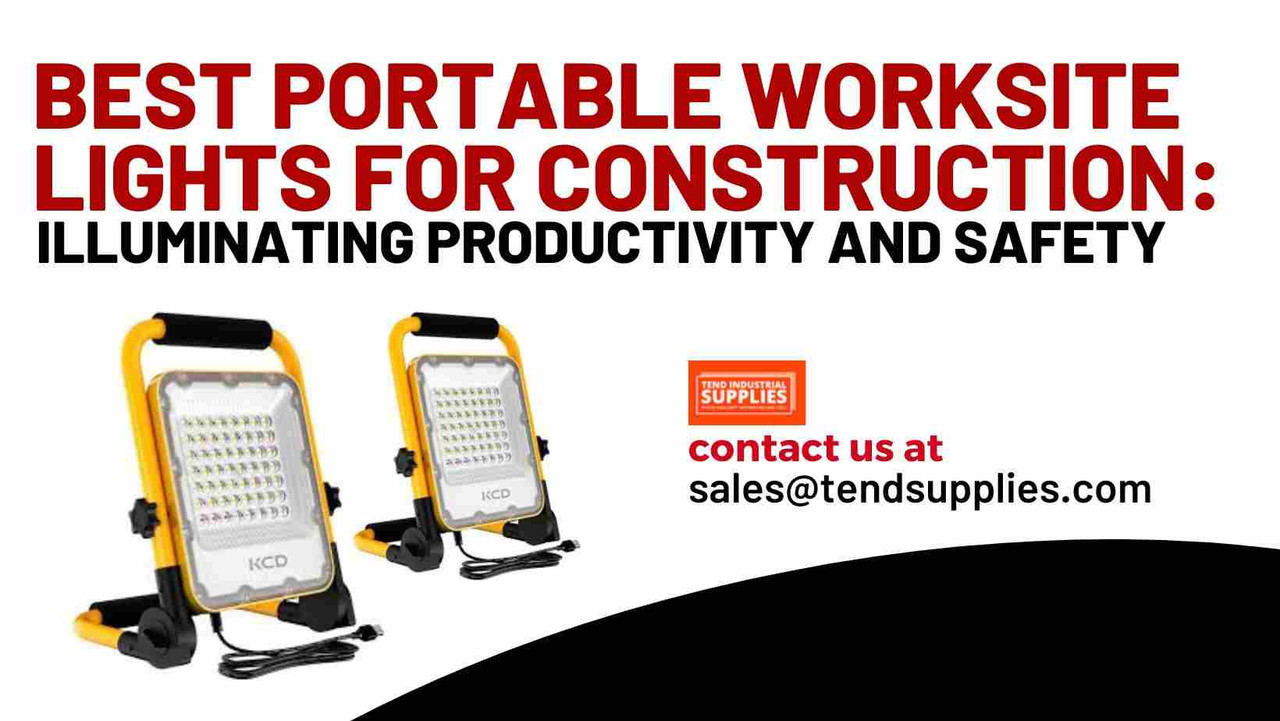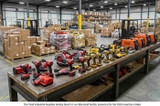Best Portable Worksite Lights for Construction: Illuminating Productivity and Safety
Key Takeaway
- Enhanced Visibility: Quality portable worksite lights significantly improve visibility, reducing errors and accidents on construction sites.
- Increased Productivity: Proper lighting enables workers to perform tasks more efficiently, boosting overall productivity.
- Safety Compliance: Investing in good lighting solutions helps meet safety standards and creates a safer working environment for all employees.
Introduction
Investing in high-quality portable worksite lights ensures safety, productivity, and quality in construction projects. You can select lighting solutions that meet your specific project needs by considering factors such as brightness, durability, portability, and energy efficiency. Remember that the right lighting illuminates the work area and contributes to worker well-being, project efficiency, and overall success.
Adequate lighting ensures that workers can clearly see their tasks, reducing the risk of errors and accidents caused by poor visibility. Moreover, well-lit worksites enhance overall efficiency by enabling workers to perform their duties more accurately and quickly. The right portable worksite lights can transform a dim, hazardous area into a bright, safe, and efficient workspace, ultimately contributing to higher productivity and a safer working environment. Investing in quality lighting solutions not only helps in meeting regulatory safety standards but also fosters a more productive and positive atmosphere on the construction site.
This comprehensive guide will explore the best portable worksite lights for construction, helping you decide to illuminate your projects effectively.
The Importance of Quality Lighting in Construction
Before diving into specific products, it's essential to understand why investing in high-quality portable worksite lights is crucial:
- Safety: Proper lighting reduces the risk of accidents and injuries on the job site.
- Productivity: Well-lit areas allow workers to perform tasks more efficiently and accurately.
- Extended Work Hours: Quality lighting enables work to continue in low-light conditions, potentially speeding up project timelines.
- Quality Control: Good lighting ensures that workers can see details clearly, improving the overall quality of work.
- Compliance: Many jurisdictions have specific lighting requirements for construction sites.
Key Features to Consider in Portable Worksite Lights
When evaluating portable worksite lights, consider the following features:
1. Brightness and Lumens
The brightness of a light is measured in lumens. For construction sites, look for lights with at least 2,000 lumens for small areas and up to 20,000 lumens for larger spaces.
2. Color Temperature
Color temperature, measured in Kelvin (K), affects how the light appears:
- 2700-3000K: Warm white, good for indoor work
- 4000-5000K: Cool white, ideal for most construction tasks
- 5000-6500K: Daylight, best for detailed work and color matching
3. Beam Angle
The beam angle determines how wide the light spreads:
- Narrow beam: For focused lighting on specific areas
- Wide beam: For general area lighting
4. Durability and IP Rating
Construction sites can be harsh environments. Look for lights with high IP (Ingress Protection) ratings:
- IP65: Protected against dust and low-pressure water jets
- IP67: Protected against dust and temporary immersion in water
5. Portability and Weight
Consider how easily the light can be moved around the site. Look for lightweight options with handles or wheels for larger units.
6. Power Source and Runtime
Options include:
- Battery-powered: Offers cordless convenience but limited runtime
- Corded electric: Provides continuous power but requires access to outlets
- Generator-powered: Suitable for remote sites without electrical access
7. Adjustability and Mounting Options
Flexible positioning allows for optimal lighting in various situations. Look for lights with:
- Adjustable stands or tripods
- Multiple mounting options (e.g., magnetic bases, clamps)
8. Energy Efficiency
LED lights are typically the most energy-efficient option, providing bright light with lower power consumption.
Top Portable Worksite Lights for Construction
Now, let's explore some of the best portable worksite lights available for construction sites:
1. LED Work Light Tower
Features:
- High lumen output (20,000+ lumens)
- Adjustable height (up to 10 feet)
- 360-degree lighting coverage
- Durable metal construction
- Generator or electric powered
Best for: Large construction areas, nighttime work
2. Rechargeable LED Floodlight
Features:
- Battery-powered with 8+ hours runtime
- 5000+ lumens
- Compact and lightweight design
- Multiple charging options (AC/DC/USB)
- IP67 waterproof rating
Best for: Medium-sized work areas, mobile teams
3. Dual-Head LED Work Light
Features:
- Two adjustable light heads for versatile coverage
- 10,000+ lumens combined output
- Sturdy tripod stand (extends up to 7 feet)
- 120-degree beam angle per head
- Corded electric power
Best for: Focused lighting on specific work areas
4. Compact LED Task Light
Features:
- 2000-3000 lumens
- Rechargeable battery with 4-6 hours runtime
- Lightweight and portable (under 5 lbs)
- Multiple mounting options (magnetic base, hanging hook)
- Impact-resistant construction
Best for: Small tasks, confined spaces, personal use
5. Inflatable LED Light Tower
Features:
- Quick setup (inflates in minutes)
- 360-degree glare-free lighting
- 10,000+ lumens
- Highly visible for safety
- Generator or electric powered
Best for: Temporary work zones, emergency lighting
6. LED String Lights
Features:
- Flexible placement along scaffolding or structures
- Linkable for extended coverage
- Low heat emission
- Energy-efficient LED bulbs
- Durable, weather-resistant construction
Best for: Continuous lighting along pathways or structures
Best Practices for Using Portable Worksite Lights
To maximize the effectiveness and longevity of your portable worksite lights:
- Proper Placement: Position lights to minimize shadows and glare.
- Regular Maintenance: Keep lights clean and check for damage regularly.
- Avoid Overloading: Use appropriate circuits and generators for high-wattage lights.
- Secure Mounting: Ensure lights are securely fastened to prevent accidents.
- Adapt to Conditions: Adjust lighting as work progresses and conditions change.
- Combine Light Types: Use a mix of flood and spot lights for comprehensive coverage.
- Consider Color Rendering: Choose lights with high CRI (Color Rendering Index) for tasks requiring color accuracy.
The Impact of Lighting on Worker Health and Safety
Proper lighting doesn't just improve visibility; it can significantly impact worker health and safety:
- Reduced Eye Strain: Adequate lighting reduces the risk of eye fatigue and strain.
- Improved Alertness: Well-lit environments help maintain worker alertness, especially during night shifts.
- Accident Prevention: Good lighting helps workers identify and avoid potential hazards.
- Improved Posture: Proper lighting allows workers to maintain better posture, reducing the risk of musculoskeletal issues.
Innovative Lighting Technologies for Construction
The construction lighting industry is continually evolving with some lighting ergonomics to watch out for:
- Smart Lighting Systems: IoT-enabled lights that can be controlled and monitored remotely.
- Solar-Powered Lights: Sustainable lighting solutions for remote or eco-conscious projects.
- Hybrid Power Systems: Lights that can switch between battery and corded power seamlessly.
- Anti-Glare Technologies: Advanced optics that reduce glare while maintaining brightness.
- Color-Changing LEDs: Lights that can adjust color temperature based on the task or time of day.
Cost Considerations and ROI
While high-quality portable worksite lights may have a higher upfront cost, they often provide a strong return on investment:
- Energy Savings: LED lights consume less power, reducing energy costs.
- Durability: Quality lights last longer, reducing replacement frequency.
- Productivity Gains: Better lighting can lead to faster, more accurate work.
- Reduced Accidents: Proper lighting can lower the risk of costly accidents and injuries.
When calculating ROI, consider:
- Initial purchase cost
- Energy consumption
- Expected lifespan
- Potential productivity improvements
- Safety benefits
Environmental Considerations
As the construction industry moves towards sustainability, lighting choices can play a role:
- Energy Efficiency: LED lights significantly reduce energy consumption.
- Reduced Light Pollution: Properly designed lights minimize unnecessary light spill.
- Recyclability: Look for lights with recyclable components.
- Solar Options: Consider solar-powered lights for eco-friendly illumination.
Regulations and Standards
Be aware of relevant regulations and standards for construction site lighting:
- OSHA requirements for minimum light levels in various work areas
- Local building codes and regulations
- Industry-specific standards (e.g., for road construction or marine projects)
- Energy efficiency standards and certifications
Case Studies: Lighting Solutions in Action
Case Study 1: High-Rise Construction
A high-rise construction project in an urban area faced challenges with limited power access and the need for consistent lighting across 50 floors. The solution:
- Combination of LED string lights for continuous illumination
- Portable rechargeable floodlights for focused task lighting
- Solar-powered lights for exterior scaffolding
Results:
- 30% reduction in lighting-related energy costs
- Improved worker satisfaction and productivity
- Enhanced safety record with zero lighting-related incidents
Case Study 2: Remote Bridge Construction
A bridge construction project in a remote area needed reliable, powerful lighting without access to the power grid. The solution:
- Diesel generator-powered LED light towers
- Supplementary battery-powered task lights for workers
- Inflatable light towers for quick setup in changing work zones
Results:
- Extended work hours, accelerating project timeline
- Improved visibility for critical tasks, enhancing quality control
- Flexible lighting solutions adapted to changing project needs
Future Trends in Construction Lighting
As technology advances, we can expect to see:
- Integration with BIM: Lighting planned and optimized through Building Information Modeling.
- AI-Controlled Lighting: Systems that automatically adjust based on work patterns and environmental conditions.
- Advanced Battery Technologies: Longer-lasting, faster-charging portable lights.
- Biodegradable Materials: Eco-friendly lighting solutions for temporary use.
- Human-Centric Lighting: Systems designed to support workers' circadian rhythms and well-being.
Conclusion
Ready to illuminate your construction site with the best portable worksite lights? Contact Tend Industrial Supplies at sales@tendsupplies.com or visit tendsupplies.com to explore our range of high-quality lighting solutions. Our experts can help you select the perfect combination of lights for your specific project needs, ensuring a well-lit, safe, and productive work environment. Don't let poor lighting dim your project's success – brighten your worksite with Tend Industrial Supplies today!









